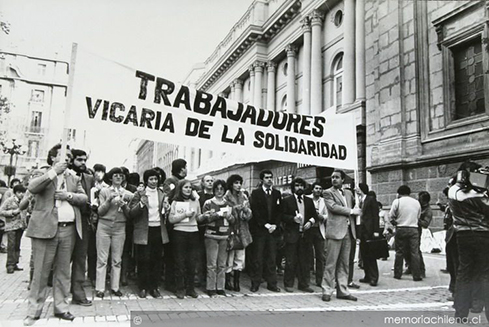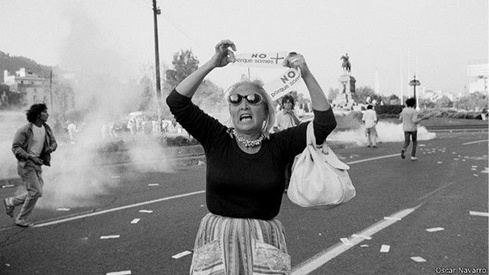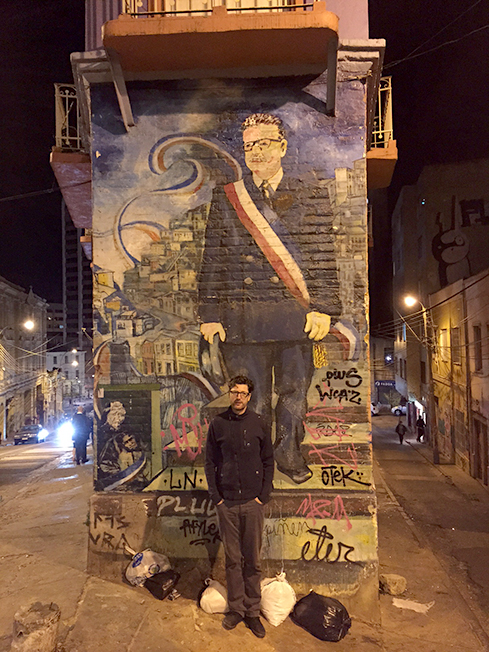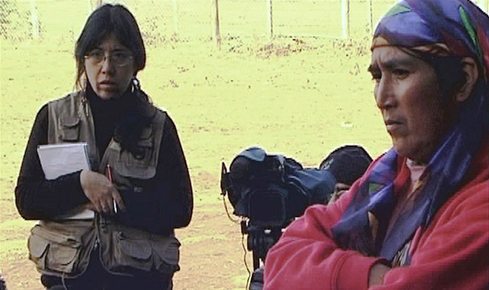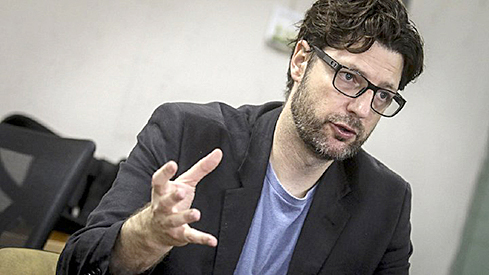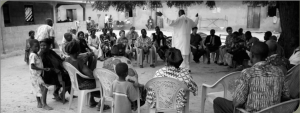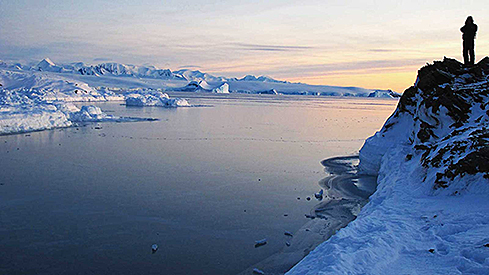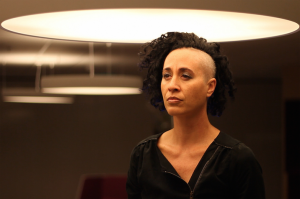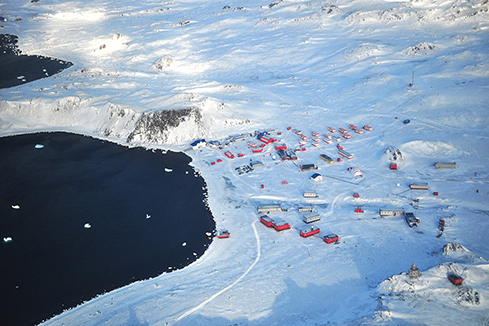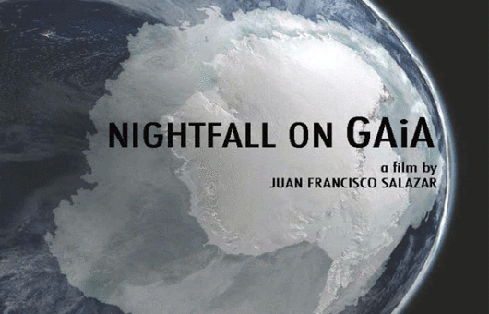In conversation with Juan Francisco Salazar
Rachel Morley
Western Sydney University
In conversation with Juan Francisco Salazar – on indigenous media, Antarctica, growing up in Chile and Argentina, and re-imagining documentary as a genre for ‘future-thinking’
Paris, July 2007. Photo by Anne Ransquin
Associate Professor Juan Francisco Salazar is a Chilean-born filmmaker, anthropologist and lecturer at Western Sydney University where he teaches documentary film and environmental humanities. He came to Australia as a postgraduate student in 1998 to begin a Masters degree at Western Sydney University (then UWS). In 2004 he completed his PhD in Communication and Media. His PhD was a combined project resulting in a thesis and a film, De la Tierra a la Pantalla, which followed the way Mapuche activists in Chile were using media as a form of counter-narrative.
As a scholar, Salazar has since gone on to establish an international reputation for his research into indigenous media practices in Latin America, visual/digital ethnographies, citizens’ media, and documentary cinemas. He has won multiple research grants, and he has written countless journal articles and book chapters. He is also co-author of the award-winning textbook Screen Media Arts: Introduction to Concepts and Practices (with Hart Cohen and Iqbal Barkat, 2008). As a media artist he has written and directed several documentary and experimental short films, which have been exhibited internationally, and he has also been a digital storytelling trainer and producer.
However, it is Salazar’s most recent work on Antarctica that has provided the impetus for this interview. As the filmmaker explains, he made his first trip to the Antarctic Peninsula in 2012 for a digital storytelling project featuring young Chilean students on an educational program. It was a trip he’d been dreaming of for some time, ever since he began sketching out maps of the ice continent as a child. The first visit was like ‘an outpost into a different planet’. Several years and several visits later, Salazar finished his first feature-length film, a speculative ethnographic documentary titled Nightfall on GAiA (2015). Shot entirely on location, GAiA is a provocative and challenging film that turns the conventions of the documentary genre on its head. As a film, it is poetic, political and thoughtful.
While Nightfall on GAiA is the focus of this interview, Salazar and I also talked about a range of other topics including his interest in community and indigenous media, early memories of cinema and storytelling, and what it was like to grow up under the rule of a military dictatorship.
Rachel Morley (RM): When did you discover your passion for filmmaking?
Juan Francisco Salazar (JFS): I don’t think I can point to a precise moment. I think it developed over time. But definitely between 1988 and 1990 when I was 17 to 19 years old. I took a class after school on German expressionist cinema and then became part of a film cooperative called Microcine del Barrio [Neighborhood microcinema] in Santiago, which was like a bar and small cinema where they would project new German cinema and Russian films starting at midnight. I learnt how to use the projector, met some obscure filmmakers, and definitely fell asleep on the couch on many nights watching films in Russian and German.
RM: Did you enjoy making and telling stories from an early age?
JFS: I have always struggled with telling stories and don’t think of myself as a good storyteller. I have always admired people that can write songs or tell jokes. I was an avid reader of stories from an early age (like Verne, Salgari, Asimov), and then in my late teens and early 20s I read a lot of poetry (like Rimbaud or Parra). Much later I discovered and fell in love with feminist speculative fiction writers such as Octavia Butler, Margaret Atwood and Ursula K. Le Guin.
RM: I find that interesting, this idea that you struggle with telling stories, given your creative and research work seems to be inherently about storytelling. Is that a site of tension for you or do you see the nature of your work differently?
JFS: I don’t think telling stories comes out naturally for me. I have many in my head but need to force them out and sometimes they just don’t want to come out.
RM: Let’s go back to that small cinema, Microcine del Barrio. It sounds like the perfect setting for a film in its own right. Can you tell me about the arts scene in Chile at that time? Was there a vibrant underground movement?
JFS: Indeed, I’ve always thought it could have made a good scene for a bizarre film set in Santiago in the early 1990s. To my knowledge no Chilean film has explored this time where there was a really vibrant underground movement, not only in Santiago but also in other cities like Valparaiso. But not so much in cinema as the industry and infrastructure had been completely shattered by the military dictatorship. In fact one of the first things the military did on the very first day of the coup was to go to Chile Films (similar to what the Australian Film Institute used to be) to start burning reels of everything they found right there on the street. Many of the films screened at Microcine del Barrio were reels saved by the Goethe Institute and the French Culture Institute in Santiago. But there was an exciting underground video activist movement, a really interesting theatre scene and, well, it was a time of feral creativity after 17 years of dictatorship.
RM: You, of course, grew up during those times – during the military dictatorships of Argentina and Chile. How do you think those early life experiences shaped your interest in film and, more specifically, the kinds of stories you’re drawn to telling?
JFS: During my time in Argentina (1971-1980) I can’t really say I was affected by the dictatorship. My grandparents were politically engaged left-wingers but my father – who was working for the Chilean foreign service in Buenos Aires when the military coup took place in Chile (1973) – was very young and not directly involved in politics, or his politics were at least moderate so he remained in his post. However, these were very difficult times as Chile and Argentina almost went to war in 1978 so I was often bullied in both countries because I felt both Chilean and Argentinean. My mother always told this story about how she and the guard living outside our house always had to check the car for bombs before taking my brothers and me to school. I became more involved in politics when returning to live in Chile in 1986 after 3 years in Colombia, during the last years of the dictatorship.
RM: 1986 was a particularly turbulent and brutal time, as I understand it. That was the year of the national protests, of Caso Quemados (when Chilean soldiers set two demonstrators, Carmen Gloria Quintana and Rodrigo Rojas, alight), increased media censorship, and then the assassination attempt on Pinochet in September. You would have still been a teenager then. Were you connected to the student resistance movement at that time?
JFS: This was the year I became politically and socially aware of what was going on in Chile and also in the world. It was a brutal way of learning. I was not directly connected to the student movement in 1986. I started to become involved the following year in 1987 during the visit of the Pope (John Paul II). I wasn’t involved in religion or anything but there were some really progressive Catholic organisations at the time which played a pivotal role in recording all the human rights abuses during the dictatorship. One was theVicaría de la Solidaridad. So the visit by the Pope was used in very strategic political ways to fight the dictatorship. I became more involved again in 1988 during the year of the plebiscite that defeated Pinochet. I was in year 12 of high school and my parents divorced that year so I spent a long time on the streets and at protests. I was bashed by police many times in these street protests, as they always turned quite violent. Nothing compares with Carmen Gloria Quintana and Rodrigo Rojas who were set on fire by police at one protest on July 2 1986. This was a massive protest that gathered several hundred thousand people. It took place on the same week as my family and I returned to Chile from Colombia. Rojas died and Quintana became a symbol of the resistance movement. She took to the stage on a packed national stadium in 1987 invited by the Pope. Today she lives in Canada.
http://www.memoriachilena.cl/602/w3-article-3547.html
Photo © Oscar Navarro Link
Valparaiso, Chile November 2013, with street art image of President Salvador Allende on background.
RM: What brought you to Australia?
JFS: Well I came to Australia 10 years after these events when things had changed quite considerably but not in the way some people had wanted. The campaign motto of the pro-democracy movement was ‘Happiness is coming’. You can see this in the film NO by Pablo Larraín, which was screened here in Australia some time ago. But this happiness never came for many people, like indigenous peoples and many more. So I came to do postgraduate studies in 1998 with my partner Alejandra and Dominga, my one-year-old daughter at the time. This was the year Pinochet was arrested in London accused of crimes against humanity. So my Masters thesis was a study of Chilean cinema in exile (1973-1990) where I used anthropological theories of rites of passage (Van Gennep, Turner) to explain the development of a Chilean cinema in exile as a rite of passage, linked to the demise of Pinochet who unfortunately walked free and died a free man. Then, a few years later, in 2000 I started a PhD thesis which was a participatory study of Mapuche Indigenous media activism in Chile.
RM: You said in your PhD thesis that you were interested in looking at the way indigenous people are ‘making culture visible through media practice’. What did you mean by this and can you give a bit of background about the Mapuche people and their history?
JFS: Well, this is such a long story I wouldn’t know where to start and finish. The Mapuche are the largest indigenous nation in Chile and Argentina with over 1 million people just in Chile. Their ancestral nation – now articulated as the Wallmapu – was established by a Treaty with Spain in 1641. It was roughly the size of modern Portugal and the treaty gave freedom to the Mapuche south of the Bio-Bio River.
In the period 1860-1890 the newly formed Chilean republic invaded and annexed these territories (not unlike similar cases in Argentina and the so-called American-Indian wars in the US in the same period). During the 20th century Mapcuhe communities lost access to their land, resources, culture and language. This was exacerbated during the military dictatorship where the state expropriated indigenous lands to sell or give away to newly formed logging companies which literally destroyed large parts of southern Chile. This generated the current conflict between the Mapuche, the Chilean State, and the logging companies that are owned by some of the richest family economic groups in Chile. My work was about communication rights and the way Mapuche activists were appropriating the media (radio, video, internet) to make their culture visible, which allowed them to tell a different story to that portrayed in the mainstream media where the Mapuche are made to be seen as lazy, drunk, violent terrorists.
RM: A concept that developed in the thesis, and which has endured in your subsequent research, is that of ‘imperfect video’. What did you mean by this?
JFS: This was an idea I developed in my PhD thesis in which I wanted to take Julio Garcia Espinosa’s notion of an imperfect cinema as a way of framing the development of indigenous video in Latin America coming out in the late 1990s. Garcia Espinosa wrote his manifesto ‘For an Imperfect Cinema’ in Cuba in 1969, a few years after Glauber Rocha had written another manifesto ‘Aesthetics of Hunger’ (1965), and Fernando Solanas and Octavio Getino had written ‘Towards a Third Cinema’ (1969). These were key filmmakers from the so-called New Latin American cinema movement of the 1960s and 1970s. These filmmakers were trying to find a new language and a new way of making films, as well as engaging with audiences differently. If the Hollywood model represented the first cinema, a perfect cinema, and the European art cinema was a second cinema, then Latin America urgently needed a third cinema, an imperfect cinema. So I was interested in reworking these notions and updating them so I could examine the politics of films made by indigenous video-makers across Latin America.
RM: You also made a 48-minute documentary, De la Tierra a la Pantalla [From land to Screen], for the PhD, which you described as a ‘hybrid social documentary’. Were you working to apply this idea of ‘imperfect cinema’ in that film?
JFS: Yes, in part I was trying to put into practice this idea that you don’t need to make a ‘perfect’ film in terms of how the industry and television broadcasters instruct filmmakers to do.
A still from the making of of the film De la Tierra a la Pantalla.
(The woman on the left is Mapuche filmmaker Jeannette Paillan).
Alto Bio-Bio Chile, July 2002.
RM: What interests you most about community media?
JFS: I think there is a vast diversity of ways of storytelling and what draws me to community forms of storytelling is the way stories create community. The word relate, for instance, has a common origin to the word narrate. Relating (to one another) and storytelling. So in community media the telling of stories is not to sell or promote a message and a product, but to engage in communal ways of being together. That’s why I joined this amazing group called OURMedia/Nuestro Medios, a global network of academics, activists, practitioners, artists, and policy experts that come together to engage in a long-term dialogue around alternative, community and citizens’ media.
At Universidad de Valparaiso, Chile, November 2015.
At the OURMedia Conference in Ghana, August 2008
RM: What are some of the more recent community media projects you’ve worked on? I know there was the digital storytelling project in Antofagasta in Chile. I think you were working with early childhood teachers in that instance?
JFS: During the 2000s I worked with a series of indigenous organisations in Latin America where I was part of the Council for Latin American Indigenous Film and Communication (Clacpi). Then around 2008, 2009 I helped set up an early childhood education project in northern Chile. Part of my role was to develop a series of digital storytelling projects with early childhood teachers who were working in extremely vulnerable contexts. The project was called Futuro Infantil Hoy and it’s still running, led by Associate Professor Christine Woodrow from Western Sydney University’s School of Education. Futuro Infantil Hoy has become a unique pedagogical and community capacity building project in early childhood education. The program aims to strengthen leadership and pedagogical practices in early childhood centres, involving families and communities in children’s learning, and providing young children with a solid foundation for successful schooling.
RM: We’ve also worked together on a project in Ntaria in Central Australia over the last few years, which involved a digital storytelling component. How did you bring your experiences of indigenous video practices in Latin America to bear on this work?
JFS: Well, it’s not easy to say. The contexts are very different. I couldn’t say there are particular experiences that are translatable without getting into a lot of trouble. I guess the experience of working in inter-cultural, multi-lingual, community environments was useful, but the way in which indigenous communities in Central Australia and Southern Chile engage in politics on a daily basis is different.
RM: One of the other digital storytelling projects you’ve been involved in is the Digital Storytelling Project in Antarctica back in February 2012 and 2013. What was the focus of that project and how did it start?
JFS: My interest in digital storytelling began in 2007 when I was part of a workshop by a British organisation called Hi8us who came to Sydney as part of the OURMedia Conference I was convening. They delivered a workshop at ICE (Information and Cultural Exchange in Granville) and then we did a digital storytelling project with young African refugees and young, second-generation Cambodian kids. This was such a good experience that I developed a project with the Chilean Antarctic Institute to do a series of digital storytelling projects with young Chilean students on an educational program in the Antarctic Peninsula. The first project was in 2012 and the second in 2013. We worked with 17-year old kids who wanted to become scientists. And in the first year we included a 14-year old girl who had been living in Antarctica for 2 years with her family. So these became the first-ever digital storytelling projects made in Antarctica.
Opening Doors to Antarctic Science from Juan Francisco Salazar on Vimeo
RM: When did you start thinking about making a film of your own about Antarctica? Had you been dreaming about Antarctica for some time?
JFS: I became interested in Antarctica from a very early age. I must have been like 10 or 12. I was terrible at drawing, but I was really good at drawing maps. I would draw maps of every continent, and some countries, and hang them on the walls of my room. I loved drawing Antarctica and in geography classes in both Chile and Argentina they would teach students using a map that showed the Chilean or the Argentinean Antarctic territories. These are territorial claims not recognised territories under international law, and they overlap with each other and with the British claim too.
I could never tell the difference between the Chilean and Argentinean maps so I was convinced the two countries were the same, or were joined in Antarctica, and I always wondered why they had a border on the continent and didn’t have a border in the Antarctic. In 2005 when I was recovering from surgery at the intensive care unit in RPA Hospital in Sydney a friend brought me a New Scientist magazine which I liked reading since I was 18. There was a section on the future of Antarctica and I told myself that I wanted to do a project in Antarctica. In 2010 I started by attending a conference in Hobart and in 2011 I decided I wanted to make a film too.
RM: I want to talk about the film in a moment, but before we do, I want to ask you about Antarctica itself. We know it so well through images yet most of us will never visit. How do you understand the cultural space of that visual imaginary?
JFS: Antarctica began as an imaginary place and has always been a space of the imagination, as my friend Elizabeth Leane argues. The ancient Greeks hypothesised its existence as Antarktos (the anti-Arktos or ‘as opposed to the Arctic’) and for the past 2000 years Antarctica has been imagined as hostile, distant. In the imperial imaginary of the late 19th and early 20th centuries the Antarctic was most markedly conceived as empty; a space to be traversed, mapped, bounded, contained, colonised.
The history of Antarctica is beleaguered with personal narratives from male polar explorers and militaries, and for the past 50 years science and geopolitics have been the primary modes of framing an understanding of the Antarctic. So in many ways, Antarctica is the most mediated place on Earth. Most people will never go there but may have a visual idea of how it looks like. Visual mediation defines Antarctica.
RM: Can you remember your early impressions, what it was like to see and experience for the very first time?
JFS: I have never been to the deep Antarctic, which is very different to the Antarctic Peninsula where I have been three times. The place where I have conducted my research and where I shot the film is called the Fildes Peninsula and is in the southwestern corner of King George Island, one of the South Shetland Islands, located close to the northern tip of the Antarctic Peninsula within the so-called Maritime Antarctic climatic zone. The site is roughly 900 km south of Cape Horn and 1200 km southeast of Punta Arenas in Chile.
The first time I went there in 2012, I had a different experience from what I had read. It felt cosy –cold but warm at the same time. It felt like an outpost into a different planet. The first time I got there I was initially interested in observing, finding out, and describing how the little things of the local and the everyday unfold in Antarctica. How people make themselves at home and how Antarctica becomes familiar. In other words how we are making Antarctica habitable; how countries with interests in the Antarctic construct research stations that function like national/cultural enclaves.
Most importantly, the South Shetlands and the northern part of the Peninsula is today the most accessible Antarctic region, accounting for one of the highest levels of seasonal occupation by scientific parties in Antarctica. This human occupation includes summer-only refuges and field camps as well as ship-based landings, and the activities are most intensive on the sixteen permanent stations that are run by thirteen states. King George Island is the site with the largest concentration of national research activities in Antarctica, and arguably the world.
During the first trip I kept trying to be aware of the precise moment when I would first ‘see’ the Antarctic from the aircraft’s window. It was an overcast morning in February and the Antarctic Airways plane was full to the roof. I kept on thinking about the mental image that Tom Griffiths evokes when he says that ‘time-lapse photography from satellites have revealed to us that Antarctica is like a giant, breathing organism clamped to the base of the globe’. In fact I took that sentence and used it in my film. One of the first things I remember was how my body swiftly acquired a different rhythm under the three layers of clothing. It felt like an eerie yet not completely uncanny landscape. It was definitely a sensory and sensuous experience at first. A frozen desert of monotone rocks and dust; a soil-less topography of minute hills, patches of muddy ice, sharp ridges, and isolated escarpments that swell from the ocean; a lively world of animals, smells, and light I had not seen and felt before.
Photo by Pedro Niada. Antarctica, April 2011.
RM: Hearing you talk about the visual mediation of Antarctica’, and recalling those first experiences, reminds me of something I read in one of your essays. You were writing, I think, about the way images mediate and shape our understanding of the planet and the environment. You quoted Ginsberg’s response to seeing the first images from the moon in 1969: ‘No Science Fiction expected this Globe-Eye Consciousness’. You then went on to write that ‘these images opened up for the first time a path for a new kind of planetary imagination, a new form of planetary consciousness’. This is an idea that really interests me when applied to Antarctica. It leaves me to wonder how you think the legacy of the images we’ve seen have shaped our understanding of it and, perhaps, if you wanted to encourage an alternate viewing or visualisation in the film you went on to make?
JFS: This is a complex question and I don’t think I have a short answer. I guess one thing I could say is that I was interested in resisting the temptation of presenting Antarctica only as a wilderness untouched by human activities. The Antarctic has always been imagined through very particular logics of representation, and through an array of lenses, sensing devices, and technologies of representation.
From the imperial imaginary of the late 19th and early 20th centuries where the Antarctic was most markedly conceived as empty – a space to be traversed, mapped, bounded, contained, colonised – Antarctica is often envisioned as a blank page, a white space on the map, or an empty screen for the projections of culture. This is what many tourists go looking for when they go there too. Obviously it’s a majestic natural environment and areas of Antarctica remain among some of the least affected by human detritus, but I wanted to capture that other Antarctica that is being peopled by culture and technology, and waste and infrastructures.
RM: The resulting film, Nightfall on GAiA , is a provocative and thrillingly experimental work that plays on the genre and expectations of documentary cinema. For those who haven’t seen it can you give an account?
JFS: Nightfall on GAiA is a history from the future looking backward at our present moment as a turning point. A devastating planetary event has left Xuě Noon confined alone in an Antarctic research station. Her survival is a tale for the future preservation of Antarctica: the last wilderness on a fragile planet and the new frontier for human inhabitation. Xuě Noon is a Maori astrobiologist and her solitary confinement relates to radiation from unprecedented solar storms. It is late April 2043 and the absolute darkness of the polar winter is upon her. As the last sun sets over the Antarctic winterscape, Xuě digs through the ai-archives of the station, and through her innermost memories and dreams, pondering about the prospects of her confinement and her own impending death.
The film is an allegory of the unfolding and looming global conflicts over Antarctic resources, and speculates on the possible and the plausible futures of Antarctica in the context of paramount social and ecological crises. It’s told through a personal diary narrative form (akin to the diaries of polar explorers) using the poetic first-person voice-over of a fictional character. This poetic narration is juxtaposed with black and white and colour archival footage from Antarctica (1910s-1960s) and live footage filmed in the Antarctic Peninsula in 2011-2013. The dramatic conflict emerges from the hopes and fears about Antarctica and our future as a species in extreme environments.
Nightfall on Gaia (2015) Trailer – Juan F Salazar from Juan Francisco Salazar on Vimeo.
RM: Elsewhere you’ve called it a speculative ethnographic film. What do you mean by that?
JFS: I guess I mean a way of experimenting ethnographically and creatively with anticipatory and speculative narratives of life in Antarctica to express a view of how I think we are beginning to imagine – and inhabit – an anthropogenic Antarctica. The film is grounded in ethnographic fieldwork conducted in Antarctica, but is an experimental meditation on the future of the Antarctic as a new extreme frontier for human inhabitation, the complexities of a fragile planet at the verge of ecological collapse, and the vicissitudes of an uncertain geopolitical future for the region.
I guess what I developed was a speculative engagement with Antarctica that sought to identify something beyond the imaginaries of my interlocutors, who were a diverse group of transient and semi-permanent populations of scientists, military, teachers, families, logistics personnel, and tourists. It sought to find events that could be narrated with a speculative intent to show how futures are imagined and hoped for in relation to how novel forms of sociality emerge, and to demonstrate how they are performed and given substance through material entanglements and lively engagements with the more than human world.
Thinking about time in both ethnography and documentary film practice has been far less illuminating about the future than it has about the present and the past. But both knowledge practices are today also engaging in the treatment of the unsee-able; the yet to come. I have tried to test a definition of documentary beyond the classic statement of “a creative treatment of actuality” to talk about creative treatment of possibility.
RM: You’re right. Documentary has traditionally been about the past, about actuality, about trying to represent and understand the things that have happened. It rarely addresses the future and yet in so many ways it stands as a bridge to what might be possible. It feels like such a pedestrian question but I can’t help but want to know: what inspired you to re-imagine the possibilities of documentary in this way, as a genre for future-thinking?
JFS: I think it has to do first with my interest in feminist speculative fiction literature and serious science fiction. What Donna Haraway once called the SF mode: science fact, science fiction, speculative fiction, ‘speculative fabulation’. Documentary media is today a versatile mode of storytelling where factual and fiction combines seamlessly, but I wanted to take that to the limit and also experiment with multiple temporalities to push documentary practice to be able to say something, to speculate in the ‘what if’ mode.
RM: I remember talking to you a few years ago about Werner Herzog’s Antarctica documentary Encounters at the End of the World. I think you were still editing Nightfall on GAiA at the time, but you said that the kind of film Herzog had made was nearly the exact opposite of what you wanted to do. What was it about Herzog’s film that you were reacting to?
JFS: No. I watched Herzog’s film before I started editing, somewhere halfway during the shooting stage. I don’t think I wanted to do the opposite to Herzog and I wouldn’t dare compare with him in anyway. But I didn’t like the way his film made me feel about Antarctica. First, because my experience there was different. Second, because I saw Herzog as a contemporary polar explorer, almost as taken directly from a page of the heroic era of polar exploration. It’s a very masculinist film with a very particular male gaze. I wanted to try something different, a new mode of feeling of Antarctica, of embodying Antarctica, and not only of rationalising Antarctica.
RM: In an essay for Alexandra Juhasz and Alisa Lebow’s edited collection A Companion to Contemporary Documentary Film, which explores environmental cinema,you write about the etymology of the word ‘planet’, tracing it back to its Greek origins planḗtēs, which means ‘wanderer, drifter’. You say you’re compelled by how the ‘notion of wandering captures humanity’s present moment’. How so?
JFS: Well, maybe I was stretching it a bit too much. I was commissioned to organise a section called ‘Planet’ for that book. When I was finding a way to articulate an argument I went back to the etymology of the word to find that planetai in old Greek meant something like a wanderer and that planets were seen as wandering the universe. I think as a species and as a civilisation we are drifting without a clear direction.
RM: Conceptually I think it works. Certainly as you go on to write in that essay in wandering ‘wondering’ also becomes important, and this seems to point back to both the speculative and political intent of the film, which I read as deeply feminist. In fact it's was one of the things about the film that continues to strike me. To have Xuě Noon – a Maori woman and astro-biologist – in Antarctica, and as the protagonist representing the narrative voice of the future, felt marvelously radical. Thinking about it takes me back to what you were saying about Herzog, and perhaps some of those traditionally gendered ways of ‘visualising’ Antarctica that we spoke of earlier. Can you talk a bit more about what you wanted to do and say with her character?
JFS: I’ve felt frustrated that the way in which Antarctica is visualised, narrated, told, is never enough to capture the scale, the magnitude of what it means to live there now, and what the place is becoming into the future. ‘A world in the making in an extreme environment that could have been but never was’ as Xuě Noon, the main character in Nightfall on GAiA says. Perhaps enough to understand who goes there today and why, but not enough to capture a glimpse of a possible people to come – let alone of a polity to come, yet unformed and unnamed.
Haraway contends that the boundary between science fiction and social reality is ‘an optical illusion’. In the case of Nightfall on GAiA, the erasure of this boundary between ethnography, science fiction, and social reality also becomes an illusion in both the film and my ethnographic work there. At the core of this experiment in speculative anthropological storytelling is Xuě Noon in the year 2043 as the fictional/fabulated character of a Maori astro-biologist. She works at the NASA Jet Propulsion Centre and is leading a team undertaking extremophile bio-prospecting in Antarctica as preparation for the first manned expedition to Europa – one of the moons of Jupiter. She finds herself stranded in the fictional GAiA International Antarctic Station.
This is not a random fact but a critique of the fact that at the time of making the film there was no International Antarctic Station, as compared, for instance, with the International Space Station.
As a figure resembling that of the cyborg, I wanted Dr. Noon – as the AI calls her – to open up new imaginative possibilities for thinking about what Antarctica is becoming by refiguring and embodying a different structure of feeling – the negotiation that results from different ontologies but also kinds of labour in Antarctica. I didn’t want the white male bearded middle-class scientist or the weirdoes that populate the Antarctic like in Herzog’s film.
So Xuě Noon developed into this cyborg-punk looking androgynous figure who confronts herself and the ‘end of the world as we know it’ with her scientific knowledge but also with her indigenous knowledge. She is a Matakite, a seer into the future and the past in traditional Maori society, daughter of another Matakite woman. She is a fabulated character of fiction as well as social reality, created from ethnographic interviews with astro-biologists and marine biologists as well as the personal life story of the award-winning Maori performer Victoria Hunt who plays the role of Xuě Noon. In this sense Xuě Noon is a personal and modest homage to the tradition of feminist speculative fiction and I wrote her character as a result of long and intense moments during fieldwork following Antarctic microbiologists in sampling fieldtrips, observing their practices of DNA sequencing, engaging with them in undergraduate teaching; following them at international conferences; and looking at plans by NASA to send a manned expedition to Europa in the 2040s.
Victoria Hunt performs the character of Xue Noon in the film Nightfall on Gaia (Sydney October 2014).
RM: In one of your essays you call documentary cinema a ‘resource of hope’. To what extent do you think documentary and film more broadly can function as a trigger for social change?
JFS: Yes, I do think that documentary cinema and documentary media more broadly can trigger social change because it is a vital and formidable cultural strategy and device through which to think, narrate and relate to each other about how the planet has become perceivable and ‘experience-able’ as a complex set of ecosystems, but most importantly how planetary futures are being played out, mobilised, and put into practice. In the publication you mention, my concern was with interrogating whether documentary cinema’s main preoccupation with ‘representing the past’ and ‘documenting the real’ can be tested (or defied) by speculating about documentary film’s potential for rendering an anticipatory futuring of socio-ecological change. In both instances the aim is to propel documentary cinema as a resource of hope (in the sense of Raymond Williams’ use of the term) in light of current social and ecological predicaments and the propinquity of unprecedented planetary crises.
RM: I want to ask you about the experimental qualities of Nightfall on GAiA in terms of the structure, as well as your process in both conceiving of and editing it. In an interview with Kate Nash, Florian Thalhoffer (designer of Korsakow software), spoke about his interest in open structures of storytelling and in ‘patterns and how to make interesting patterns emerge’. He went on to say that ‘a good way to do that is to go out and collect bits and pieces and then later think about the different connections those bits and pieces might have.’ Obviously you haven’t made a Korsakow film here, but I recall you saying at a point that you didn’t go into Antarctica with a script or a fully formed story. Did you find yourself collecting ‘bits and pieces’ and then allowing the story to emerge or was your process informed by a different approach?
JFS: Well, I haven’t read this work, but it definitely describes the way I went about constructing a story by collecting bits and pieces and then bringing them alive in the editing room. I guess I was drawing inspiration first on Raul Ruiz, a cult Chilean filmmaker and theorist who wrote against what he called the theory of the central conflict.
For Ruiz to assert that a story can’t exist without a central conflict (as in the Hollywood system and the Aristotelian tradition) obliges us to eliminate all those other stories that do not revolve around a confrontation, meaning that we push aside those to which we are indifferent or that only spark in us a vague curiosity. Like in my film it could be a sea lion sleeping, a glacier standing still (in our perspective as glaciers are not still), a man making bread, a DNA sequencing instrument, a priest playing bell music in an orthodox church, a whiteout. These fragments of scenes are relationally meaningful but not in a cause and effect relationship with each other or organised around a dramatic conflict or something that is at stake for someone or something. I guess I saw a role for me as a filmmaker that becomes an ‘agent provocateur’.
RM: The film has been shown at a number of festivals now, namely Antenna International Film festival (Sydney), the RAI Ethnographic Film Festival (Bristol); the Copenhagen Documentary film festival, among others. How have audiences responded?
JFS: I think audiences have responded in different ways. Many really like the film as it invites people to ‘travel’ in space and time and ‘experience’ or ‘feel’ the Antarctic in very different ways. To engage with the people who live there, the materiality of the ice, the more than human world, etc. Many react against the experiment that blends fact and fiction and, I think, dislike the hybrid nature of the film because the film does not give audiences too many coordinates to orient them. It’s not an easy film. It’s an imperfect film in terms of its narrative construction that shows fragments of realities without a narrative arc and a clear dramatic conflict. Many people have asked why bother with a science-fictional movie while other wanted more of the fictional and less of the factual. Some people have felt it stays too much on humans and not enough on animals, others the opposite, there is not enough of the human story and too many images of animals and ice. But regardless, the film leaves audiences thinking and feeling about Antarctica in very particular ways and I think this is an achievement that makes me happy.
Aerial view of Fildes Peninsula research stations; King George Island, Antarctica. June 2011. Photo by Pedro Niada.
http://www.nightfallongaia.net/
About the interviewer
Rachel Morley is a Lecturer in Writing and Communications at Western Sydney University. Her work has been published in Life Writing, Sydney Review of Books, Colloquy, Meanjin, Literature Compass and Journal of Australian Studies. She has also published essays in the edited collections Lesbian Academic Couples, Michael Field and the World and Metafiction and Metahistory in Contemporary Women’s Writing.Rachel is Postgraduate Editor of Global Media Journal: Australian Edition and convener of the award winning, national postgraduate training event, ‘Creative Ecologies: A Postgraduate Retreat in Creative Arts Scholarship’.


